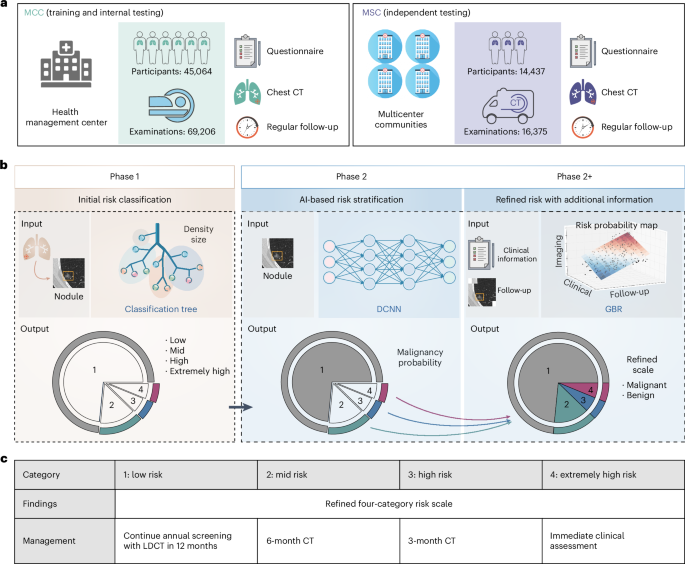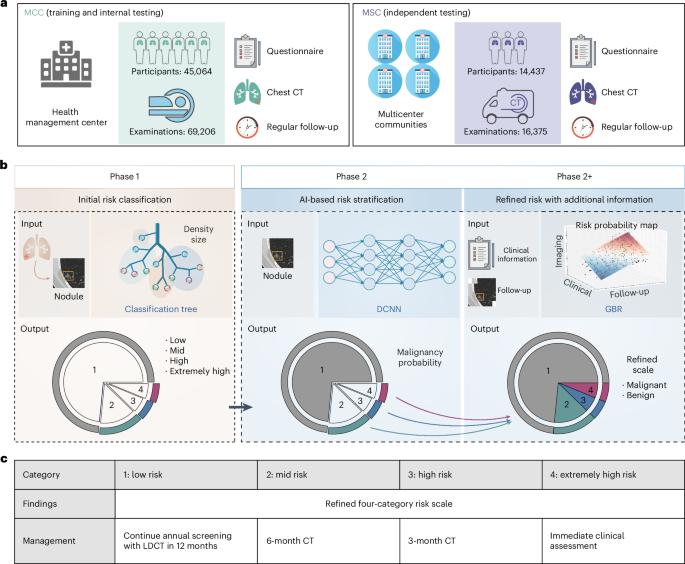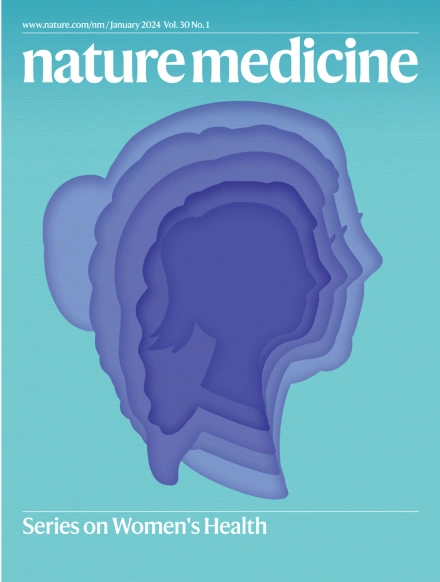Data-driven risk stratification and precision management of pulmonary nodules detected on chest computed tomography
IF 58.7
1区 医学
Q1 BIOCHEMISTRY & MOLECULAR BIOLOGY
引用次数: 0
Abstract
The widespread implementation of low-dose computed tomography (LDCT) in lung cancer screening has led to the increasing detection of pulmonary nodules. However, precisely evaluating the malignancy risk of pulmonary nodules remains a formidable challenge. Here we propose a triage-driven Chinese Lung Nodules Reporting and Data System (C-Lung-RADS) utilizing a medical checkup cohort of 45,064 cases. The system was operated in a stepwise fashion, initially distinguishing low-, mid-, high- and extremely high-risk nodules based on their size and density. Subsequently, it progressively integrated imaging information, demographic characteristics and follow-up data to pinpoint suspicious malignant nodules and refine the risk scale. The multidimensional system achieved a state-of-the-art performance with an area under the curve (AUC) of 0.918 (95% confidence interval (CI) 0.918–0.919) on the internal testing dataset, outperforming the single-dimensional approach (AUC of 0.881, 95% CI 0.880–0.882). Moreover, C-Lung-RADS exhibited a superior sensitivity compared with Lung-RADS v2022 (87.1% versus 63.3%) in an independent cohort, which was screened using mobile computed tomography scanners to broaden screening accessibility in resource-constrained settings. With its foundation in precise risk stratification and tailored management, this system has minimized unnecessary invasive procedures for low-risk cases and recommended prompt intervention for extremely high-risk nodules to avert diagnostic delays. This approach has the potential to enhance the decision-making paradigm and facilitate a more efficient diagnosis of lung cancer during routine checkups as well as screening scenarios. Trained on a cohort of 45,064 cases and validated on data acquired from mobile computed tomography scanners deployed in rural China, a lung cancer screening deep learning model is shown to outperform existing lung cancer risk scores.


胸部计算机断层扫描检测到的肺结节的数据驱动风险分层和精确管理
随着低剂量计算机断层扫描(LDCT)在肺癌筛查中的广泛应用,越来越多的肺结节被发现。然而,精确评估肺结节的恶性风险仍是一项艰巨的挑战。在此,我们提出了一个分诊驱动的中国肺结节报告和数据系统(C-Lung-RADS),利用了一个包含 45,064 个病例的体检队列。该系统以循序渐进的方式运行,最初根据结节的大小和密度区分低危、中危、高危和极高危结节。随后,该系统逐步整合了成像信息、人口统计学特征和随访数据,以精确定位可疑的恶性结节并完善风险等级。在内部测试数据集上,多维系统达到了最先进的性能,曲线下面积(AUC)为 0.918(95% 置信区间(CI)为 0.918-0.919),优于单维方法(AUC 为 0.881,95% CI 为 0.880-0.882)。此外,与 Lung-RADS v2022(87.1% 对 63.3%)相比,C-Lung-RADS 在一个独立队列中表现出更高的灵敏度。该系统以精确的风险分层和量身定制的管理为基础,最大限度地减少了低风险病例不必要的侵入性手术,并建议对极高风险的结节进行及时干预,以避免诊断延误。这种方法有可能加强决策范式,促进在常规检查和筛查中更有效地诊断肺癌。
本文章由计算机程序翻译,如有差异,请以英文原文为准。
求助全文
约1分钟内获得全文
求助全文
来源期刊

Nature Medicine
医学-生化与分子生物学
CiteScore
100.90
自引率
0.70%
发文量
525
审稿时长
1 months
期刊介绍:
Nature Medicine is a monthly journal publishing original peer-reviewed research in all areas of medicine. The publication focuses on originality, timeliness, interdisciplinary interest, and the impact on improving human health. In addition to research articles, Nature Medicine also publishes commissioned content such as News, Reviews, and Perspectives. This content aims to provide context for the latest advances in translational and clinical research, reaching a wide audience of M.D. and Ph.D. readers. All editorial decisions for the journal are made by a team of full-time professional editors.
Nature Medicine consider all types of clinical research, including:
-Case-reports and small case series
-Clinical trials, whether phase 1, 2, 3 or 4
-Observational studies
-Meta-analyses
-Biomarker studies
-Public and global health studies
Nature Medicine is also committed to facilitating communication between translational and clinical researchers. As such, we consider “hybrid” studies with preclinical and translational findings reported alongside data from clinical studies.
 求助内容:
求助内容: 应助结果提醒方式:
应助结果提醒方式:


